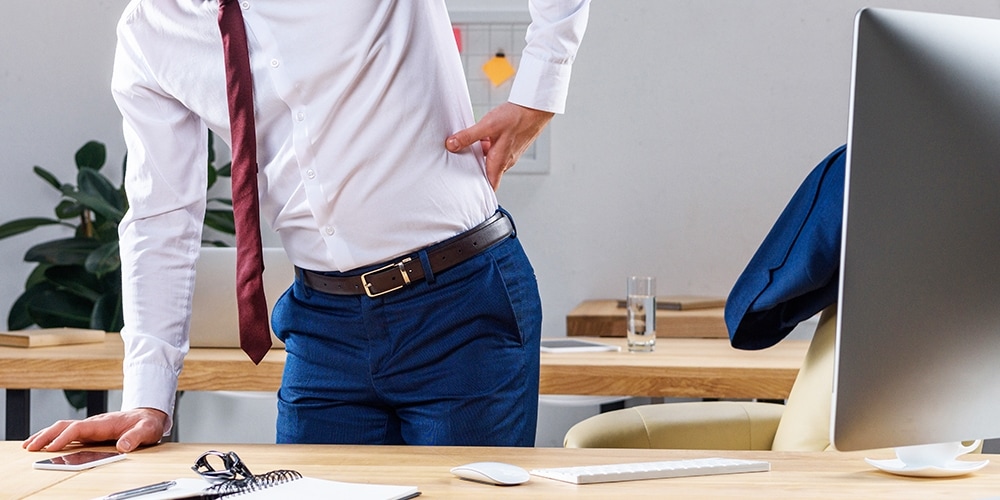Understanding Back Pain
Back pain is one of the main causes of incapacity for work. One in three adults suffers from frequent or permanent back pain.
A few reasons why back pain has become so common include :
- High volumes of sedentary desk work.
- Poor postural habits.
- Low activity lifestyles.
- High proportion of social and recreational activities that involve sitting.
- Too much screen time starting at younger ages.
Understanding Different Types of Back Pain
Back pain is a kind of personal experience, the intensity of back pain is different for each person. Also, with some back conditions, your pain can explode and then quickly subside, only to come back even worse after a few weeks or months.
Problems with numerous structures in your back can cause pain. Your spine is susceptible to injury because it is exposed to many strong forces and daily stresses, such as excessive sitting and poor posture.
Common anatomical causes of back pain include :
- The large nerve roots that travel to your legs and arms may be irritated.
- The large paired back muscles that support the spine may be strained.
- Any of the bones, ligaments, or joints throughout your spine may be damaged
- Sometimes, the underlying cause of pain can be hard to identify.
Common classifications of back pain include :
- Axial pain. Also called mechanical pain, axial pain may be described in several ways, such as sharp or dull. A muscle strain is a common cause of axial pain.
- Referred pain. Often characterized as dull and achy, referred pain tends to move around and vary in intensity. Degenerative disc disease in your lower back may cause referred pain to your hips and posterior thighs.
- Radicular pain. Typically described as deep and searing pain, radicular pain follows the path of a nerve and may be accompanied by numbness or weakness. This type of pain is caused by conditions that compress a spinal root like a herniated disc.
Knowing how to describe your pain is important. Accurately describing the type of pain you're experiencing and identifying the area of distribution of your pain can be helpful in order to determine the cause of your pain.

Benefits of physical activity and sport
Physical inactivity is not only linked to the development of certain cardiovascular and metabolic diseases. Static posture in a sitting position with constant pressure on intervertebral discs and lack of activity and therefore decreased circulation blood in our muscles can cause excessive pressure, tension and joint injuries.
Improper use of computers and laptops, workstations and work environments poorly designed, can lead to back pain. Thanks to a workstation design tailored to individual needs and « small breaks », these problems can be avoided.
However, these corrections do not replace sport or regular physical exercise, which greatly reduces the risk of back pain !
Sport helps to avoid muscle imbalances and to provide spine stability. For chronic back pain, exercise and sport programs may prevent recurrence and help to reduce the duration and severity of back pain.
Tips to Improve Posture While Sitting
- Sit with your head in a neutral position by keeping the ears directly above the shoulders.
This better posture reduces neck stress by allowing your head to stay naturally balanced on the cervical spine. - Avoid holding your head at a tilt for an extended period.
- When working in the computer your eyes should be level with the top-third of the monitor.
- Keep your feet flat on the floor to minimize stress on your hips and spine.
- Your knees should be about even with your hips. If your feet can’t comfortably reach the floor, try using a footrest.
- Have arms rest comfortably at your sides while flexing your elbows between 75 and 90 degrees.
- You want your shoulders back yet relaxed, and your wrists straight, not bent. Chairs with armrests can help.
Streching
Regularly stretching the muscles, tendons, and ligaments that support the spine is an important element of all back exercise programs.
Benefits of stretching include :
- Reducing tension in muscles supporting the spine ; tension in these muscles can worsen pain from any number of back pain conditions.
- Improving range of motion and overall mobility.
- Reducing risk of disability caused by back pain.
Pain that lasts longer than 3 months (chronic pain) may require weeks or months of regular stretching to successfully reduce pain. Stretches may be included as part of a physical therapy program, and/or recommended to be done daily.

To conclude, remember that understanding your back pain and practicing regular physical activity are two key points in order to cope with back pain. In his way, you will be better equipped to deal with your pain and get better results.
Stay healthy.
